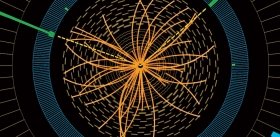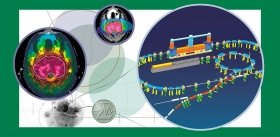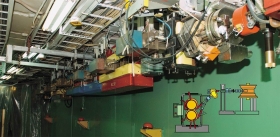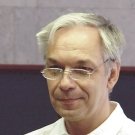On Fast Electrons
On the Day of Russia, June 12, 2010, the presentation of State Prizes of the Russian Federation for 2009 took place in the Georgievsky Hall of the Grand Kremlin Palace. The State Prize of the Russian Federation is the highest recognition of achievements of scientists and cultural workers for the benefit of society and nation. The prize is awarded for outstanding works, discoveries, and achievements that fostered the Russian and world science and had a considerable impact on advancements in science. This is a personal prize, awarded, as a rule, only once in one’s lifetime. This year, the awarding of State Prizes in the field of science and technologies was a real triumph for Siberian science: Novosibirsk scientists have received two of the three prizes. The highest state award was given to Doctor of Physics and Mathematics N.A. Vinokurov (Institute of Nuclear Physics SB RAS) for developing and creating free electron lasers and to Academician V.N. Parmon (Institute of Catalysis SB RAS) for his contribution to the development of theory and practice of catalytic methods of deep processing of hydrocarbon raw materials and use of renewable resources. And now, we are giving the floor to the laureates
Free electron lasers are high-power sources of coherent radiation that originates together with the motion of charged particles in a periodic magnetic field and is close to synchrotron radiation. The major application area of such facilities is investigations in the sphere of material science, chemistry, crystallography, solid-state physics, and molecular biology
Devices that transform the energy of electrons moving almost at the velocity of light to the energy of electromagnetic radiation got the name free electron lasers (FELs).
A universally recognized advantage of this device, which distinguishes it from other lasers, is the ability to obtain monochromatic radiation at any wavelength in an extremely wide range, from 0.1 nm to 1 mm. In this case, relatively fast switching of the laser from one wavelength to another in an interval of up to a few tens of percent is possible.
Radiation amplifier
The process of radiating an electromagnetic wave by an electric charge can be presented as separation of a part of its electric field. This means that in empty space, only those charges that move with acceleration can radiate. For an electron to radiate, it must be made to move in a wave-like manner. Such motion can be caused, for instance, by a static electric or magnetic field.
As early as 1947, the Soviet physicist V. L. Ginsburg proposed that a periodic field be used to enhance the radiation intensity of a fast charged particle, and calculated the parameters of such radiation. Later, a device called undulator was created. The undulator creates a periodic magnetic field to organize specific motion of electrons in a wavy trajectory along the longitudinal axis of the device. The resulting enhancement of electromagnetic radiation forms the basis for the operating of a free electron laser, which is an electromagnetic radiation amplifier.
The device owes its name to the fact that lasers of other types use the radiation of electrons bound to their atom, or, in semiconductor lasers, to a crystal. However, in a FEL electrons are not quite free either, since they make forced oscillations in the undulator. The operation of any laser is based on the phenomenon of stimulated emission of radiation resulting from the synchronization of individual radiators (electrons, atoms, molecules) by an external wave. In a FEL, synchronization takes place due to longitudinal bunching of electrons.
Unfortunately, the electron efficiency of a FEL (the portion of energy of electrons transformed to the energy of electromagnetic radiation) is not high: not more than 1 %. This is due to the loss of synchronism of decelerated electrons.
The return of radiation from the amplifier output to its input can cause self-excitation of the amplifier, transforming it into a generator. In the case of a FEL, it is transformed to a generator with the help of an optical cavity, i. e. two mirrors located to the left and to the right of the undulator on its longitudinal axis. An electromagnetic wave circulates between the mirrors, intensifying each time it passes through the undulator. To compensate the diffraction divergence of radiation, the mirrors are often concave.
However, the radiation intensity increase of such a generator is limited, which is caused, for instance, by practically complete bunching of electrons in the second half of the undulator.
HOW THE FEL AMPLIFIES LIGHT
Let us imagine that a monochromatic electromagnetic wave of length λ and a beam of fast electrons enter the undulator. The electrons are uniformly distributed along the longitudinal axis of the device and move at velocity v, which is almost equal to the velocity of light.Each electron moves in the undulator along a slightly wavy trajectory. For a strong (resonant) electron-electromagnetic wave interaction, the following condition of synchronism must be satisfied: passing one period of the trajectory, an electron must lag behind the wave exactly by its length, λ (due to very large velocities, λ is very small).
If the energy of electrons and the wavelength are such that the synchronism condition is satisfied, redistribution of the particle energy takes place.
At first the electron energy is modulated, but the average energy of electrons does not change. Then the bunch is divided into layers λ/2 thick, with an alternating sign of energy deviation from the initial value.
However, particles with smaller energy fly more slowly, and those with larger energy, faster. As a result, “fast” layers overtake “slow” ones; this causes electron density modulation approximately with a period λ.
The same takes place in the second half of the undulator: there is deceleration and acceleration of alternating layers; now, however, energy is lost by the layers with larger density of particles, and acquired by layers with smaller density. In this case, the average energy of electrons decreases and, according to the energy conservation law, the electromagnetic wave power increases. This is how the FEL amplifies electromagnetic radiation using the energy of fast electrons
The research instrument
The construction of charged-particle accelerators has always been one of the major and traditional tasks for the Institute of Nuclear Physics SB RAS; therefore, the institute is permanently interested in the developing FELs.
The development of free electron lasers was started by the institute in 1977, when A. N. Skrinsky and N. A. Vinokurov proposed a FEL modification (an optical klystron), which considerably increased the device amplification in comparison to the classical scheme. While new FELs were being developed, a permanent magnet undulator with control of the magnetic field amplitude by changing of the gap was implemented for the first time in the world. Several years later, there emerged hybrid undulators on permanent magnets. Now, both the variable gap and the hybrid construction of undulators are universally accepted and used in all synchrotron radiation sources.
ELECTRON “DRIVERS”
For a FEL to operate efficiently, a high-energy electron beam with small transverse dimensions and small velocity spread is required. Such beams can be obtained only on electron accelerators, which are the most complicated, large-size, and expensive part of FEL facilities. Now an electron accelerator can extend over hundreds of meters, and its energy consumption can reach tens of megawatts. Due to low electron efficiency of an FEL, it is desirable that the energy of spent electrons be returned to the accelerating system. Two types of such accelerators are used in FEL facilities.One accelerator type, widely used in basic research, is an electron storage ring, where electrons move along a closed trajectory (orbit). An electron can stay in the storage ring for several hours, its life time limited due to the scattering on the molecules of residual gas (which is always present in the storage ring vacuum chamber). Such accelerators are used in experiments on elementary particle physics and to generate X-ray radiation.
When a storage ring is used, the electron bunch that has released part of its energy in the FEL undulator passes through the accelerator bending magnets and returns to the FEL for recurrent use. Since, interacting with radiation in the undulator, some particles are accelerated and the others are decelerated, every time the electron bunch passes through the FEL its energy spread increases. Although the average energy loss by the radiating electrons is compensated by the radio-frequency (RF) cavity with a longitudinal electric field, the increasing energy spread of particles limits the average radiation power of the FEL with a storage ring to several watts.
To increase the FEL radiation power, in 1978 A. N. Skrinsky and N. A. Vinokurov proposed using the so-called energy recovery linac (ERL). In such an accelerator, an electron bunch accelerated in several, located in tandem, RF cavities release a part of its energy in the FEL undulator. Then the bunch is decelerated in the same RF cavities returning the energy spent on its acceleration. The use of ERLs makes it possible to obtain large average electron current and significantly decreases the radiation hazard of the facility.
Modern free electron lasers that use ERLs generate radiation with an average power of over 10 kW. The possibility of using such units to obtain radiation with an average power of over 100 kW has been theoretically justified
The original long undulator of the the optical klystron on the VEPP-3 storage ring, which was made in 1988, was so good that it was used more than 20 years at Russian and US facilities. It allowed us to obtain radiation of a record short (for FELs) wavelength of 0.24 micron in the ultraviolet range and of an unprecedentedly narrow (10-6) spectrum. This record was not broken for over 10 years.
An important stage of developing the FEL in Novosibirsk Akademgorodok was the creation of the Siberian Center for Photochemical Research on the basis of the Institute of Chemical Kinetics and Combustion SB RAS, headed, in the early 1990s, by Academician Yu. N. Molin.
By that time, the researchers of the Institute’s Laboratory of Laser Photochemistry, headed by A. K. Petrov, had long been working on this theme. They actively supported the idea of sharing, by specialists in various fields, the radiation from a high-power laser unit on fast electrons that can easily vary its parameters in a wide range. Despite the well-known difficulties of the “transitional” decade and owing to the enthusiasm of the project participants, the first-stage FEL with wavelengths in the range from 120 to 240 micron was put into operation in 2003. It should be noted that its average power of 500 W is the world record for radiation sources in the terahertz frequency range.
In 2009, the second-stage FEL started operating. It produced coherent radiation with wavelengths of 40—80 µm and with an average power of about 500 W, so far the highest in the world. This year, radiation from the second-stage FEL has become available for experiments in various fields of science.
Laser radiation generated by the device is delivered, through a channel with dry nitrogen, to user stations, where it is used by researchers from academic institutes and Novosibirsk State University for investigations in solid-state physics, chemistry, and biology, including investigations at the nanostructural level. Six experimental stations of this type are now fully operational.
The use of high power submillimeter radiation with a tunable wavelength as a unique research tool opens up new possibilities and prospects. For instance, the researchers of three SB RAS institutes jointly developed a “soft ablation” technique to investigate biological macromolecules (say, DNA); it uses the low photon energy of submillimeter radiation. The photon energy is so small that the radiation does not destroy the molecule under investigation but preserves its biological activity.
In the nearest future, it is planned to further increase the radiation power of operational lasers and deploy a third-stage FEL with wavelengths in the near infrared range of 5—30 µm. Challenging and promising, this research field never lacks plans.
THE FUTURE CANNOT BE PREDICTED
Owing to the high brightness of radiation out of a long undulator of the VEPP-3 electron storage ring, a series of unique experiments which studied the influence of quantum fluctuations on the motion of a single electron circulating in the storage ring were successfully performed. This motion was shown to be such as if caused by the action of a random force; it is similar to the Brownian motion of a small particle in a liquid. However, there are basically different reasons for the randomness of these processes.The trajectory of Brownian motion is not truly random, since if the initial velocities of molecules in a liquid are known, one can, in principle, calculate the motion of both the molecules themselves and of the particle subject to their impacts. The random character of Brownian motion is due to the fact that we do not know these microscopic parameters of the system. In the case of motion of an electron, all parameters needed for the calculation are known, but the motion of the electron is fundamentally unpredictable.
The experiments performed provide one of few examples of a truly random process, which proves, in particular, that the future cannot be foretold and that “God plays dice”
References
Agafonov A. V., Lebedev A. N. Free electron lasers. Moscow: Znanie, 1987.
Brau C. Free-Electron Lasers. Boston: Academic Press, Inc., 1990.
Kulipanov G. N. Invention of undulators by V. L. Ginsburg and their role in modern sources of synchrotron radiation and free electron lasers // Uspekhi fizicheskikh nauk. 2007. 177. P. 384.
Marshall T. Free electron lasers / Transl. from English, Moscow: Mir, 1987.













